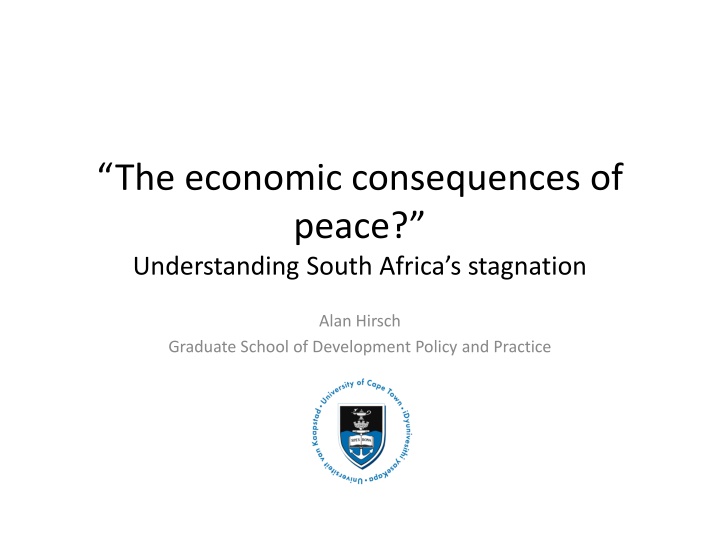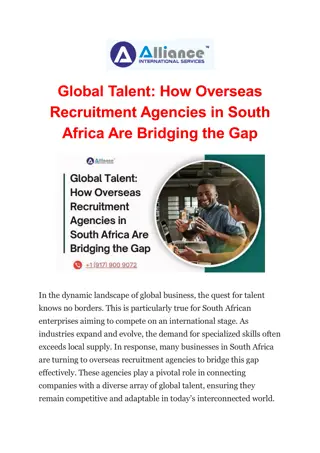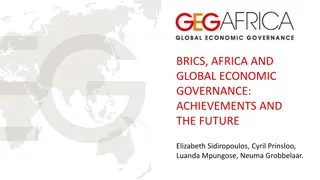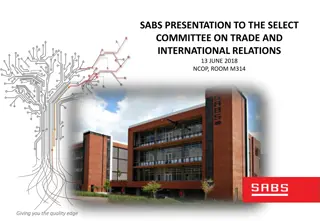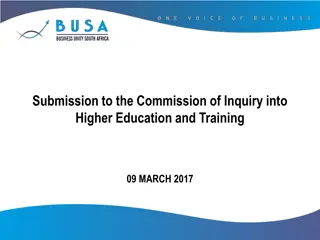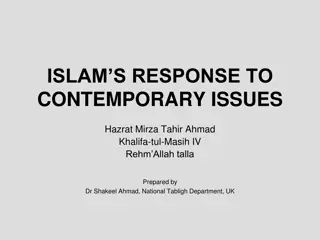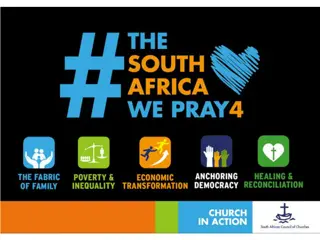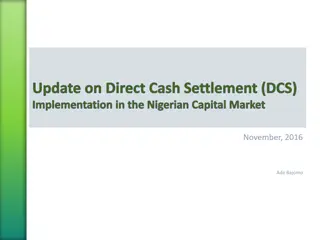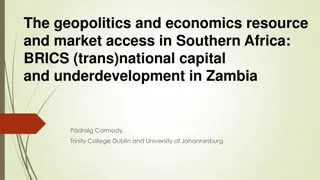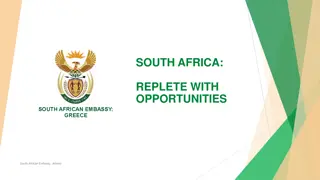Economic Stagnation in South Africa Post-Peace Settlement
South Africa's slow economic growth compared to its peers is attributed to a moribund economy with weak exports, low investment, poor innovation, and limited competition. The 1994 political settlement, while miraculous, hindered necessary transformations to address inequality and foster growth, leading to social unrest and challenges in implementing reforms.
Download Presentation

Please find below an Image/Link to download the presentation.
The content on the website is provided AS IS for your information and personal use only. It may not be sold, licensed, or shared on other websites without obtaining consent from the author.If you encounter any issues during the download, it is possible that the publisher has removed the file from their server.
You are allowed to download the files provided on this website for personal or commercial use, subject to the condition that they are used lawfully. All files are the property of their respective owners.
The content on the website is provided AS IS for your information and personal use only. It may not be sold, licensed, or shared on other websites without obtaining consent from the author.
E N D
Presentation Transcript
The economic consequences of peace? Understanding South Africa s stagnation Alan Hirsch Graduate School of Development Policy and Practice
In his analysis of the outcome of the Versailles peace talks at the end of WW I, Keynes argued that the settlement was too tough on the losers and that the consequence would be further crises Here it is argued that the settlement of the South African struggle for freedom was too soft on the losers , the consequences of which are economic stagnation and a difficult environment for reform 2
Structure of argument 1. South Africa is growing slowly relative to its peers 2. This is because the economy is moribund relative to peers (weak exports, low investment, weak innovation, poor competition) 3. South Africa is more unequal than its peers especially in the gap between insiders and outsiders 4. Ironically, the miraculous political settlement of 1994 inhibited the transformation needed to address inequality and growth 5. High inequality and slow growth preceded the transition but are rooted in the settlement and have undermined social cohesion and political legitimacy 6. Under these circumstances reform is challenging in the near term 7. But near term reforms are not impossible, and we should celebrate, defend and build on islands of excellence 3
South Africa is growing slowly relative to its peers Bhorat, Cassim and Hirsch, (2015) 4
A growth trap? Average Annual growth of GDP per capita between 1990 and 2013 Bhorat, Cassim and Hirsch, (2015) 5
Low investment Bhorat, Cassim and Hirsch, (2015) 6
Inward investment pattern Bhorat, Cassim and Hirsch, (2015) 7
Poor trade performance Bhorat, Cassim and Hirsch, (2015) 8
Anatomy of a Growth Trap Ratio of export production relative to South Africa, 2000 and 2012 High- Insurance and financial services (% of commercial service exports) Agricultural raw materials exports (% of merchandise exports) Manufactures exports Ores and metals exports technology exports (% of manufactured exports) Food exports (% of merchandise exports) (% of merchandise exports) (% of merchandise exports) Brazil 2.34 0.93 0.9 3.3 0.47 1.76 China 4.68 0.18 1.75 0.41 0.07 0.26 India 1.18 0.7 1.32 1.19 0.21 0.67 Indonesia 2.31 0.26 0.87 1.58 0.3 2.41 Malaysia 9.16 0.21 1.36 1.08 0.06 1.1 Philippines 11.69 0.13 1.59 0.78 0.14 0.28 Turkey 0.39 0.43 1.55 1.2 0.12 0.27 Korea, Rep. 5.4 0.56 1.71 0.14 0.08 0.4 Notes: High-technology exports are products with high R&D intensity, such as in aerospace, computers, pharmaceuticals, scientific instruments, and electrical machinery. Source: World Bank (2014), Bhorat, Cassim and Hirsch, 2015
Competition in product markets is low: OECD Product market regulation index 10
And the regulatory burden is high Especially in network industries 11
Innovation capacity Science, Engineering and Technology Graduates Ratio of graduates at tertiary institutions in SET, 1994-2011 7 6 Ratio against South Africa 5 4 3 2 1 0 China Malaysia Republic of Korea Turkey Brazil Notes: Brazil, Malaysia, Korea and Turkey reflect engineering, construction and manufacturing graduates; South Africa reflects the Science, Engineering and Technology graduates and China reflects Maths, Science and Engineering graduates. Source: The Presidency (2012); UNESCO (2014), Bhorat, Cassim and Hirsch (2015)
International patent registration Declining global rank Source: DPME Development Indicators 2014, South African Presidency 13
Weakening expenditure on innovation Value and percentage of GDP Source: DPME Development Indicators 2014, South African Presidency 14
Falling behind in competitive knowledge: Declining rank in the knowledge based economy index Source: DPME Development Indicators 2014, South African Presidency 15
Persistent high unemployment is not surprising Though the roots of high unemployment are structural Rate of unemployment 1990-1013 Bhorat, Cassim and Hirsch, (2015) 16
Equally striking is the extent and nature of inequality Inequality is persistently high in South Africa It is high in comparison with peers That the gap between the elite and the middle cohorts is very large 17
Measuring distribution Use expenditure data (NIES 2000, 2005, 2010) Expenditure per capita Facilitates comparison with Milanovic data set Disaggregated per capita shares by ventiles Measure of distribution after taxes and transfers Underestimates inequality relative to: Actual expenditure (undersamples at top) Income data Wealth data
Patterns of expenditure distribution South Africa (2000) Top 5% Next 15% Next 40% Bottom 40% 42.1% 32.2 20.2 5.5 100% Levy, Hirsch and Woolard, (2014)
Patterns of expenditure distribution South Africa (2000) 42.1% South Africa (2010) 37.5% Top 5% Next 15% Next 40% Bottom 40% 32.2 32.8 20.2 22.8 5.5 6.9 100% 100% Levy, Hirsch and Woolard, (2014)
Patterns of expenditure distribution South Africa (2000) 42.1% South Africa (2010) 37.5% Brazil (2000) Mexico (2000) Thailand (2000) Turkey (2000) 33.7% 27.9% 19.8% 23.1% Top 5% Next 15% Next 40% Bottom 40% 32.2 32.8 29.8 28.2 27.1 26.5 20.2 22.8 28.4 32.5 36.0 35.3 5.5 6.9 8.1 11.4 17.1 15.1 100% 100% 100% 100% 100% 100% Levy, Hirsch and Woolard, (2014)
What happened? Why did South Africa not transform more? Is it a matter of time? Is it too soon to judge? Is there more transformation outside of income measurements? (Yes for services, no for wealth) Is there something about the South African transition to democracy that inhibited deep reform? 22
A short history of the transition 1. Late apartheid reforms Reform initiatives e.g. Wiehahn labour reforms tri-cameral parliament abolition of influx controls From PFP and the Urban Foundation to IDASA the trajectory of Slabbert (vs. Oppenheimer on the ANC) Meeting with the ANC 85-89 business and verligtes (enlightened Afrikaners) 23
A short history of the transition 2. During the interregnum The repositioning of Business 1989-1994 The National Business Initiative Nedbank Scenarios (etc) Post-1990 engagements of business and the ANC The golden triangle and the NEF 24
A short history of the transition 3. Pro-status-quo constitutional/legal outcomes The bloated parliament and sunset clauses The sanctity of private property Independence of monetary authorities with no employment or developmental mandate The location of power over agriculture Limits to the competition law (conduct vs structure) 25
A short history of the transition 4. The rise and fall of social partnership from NEF to NEDLAC NEDLAC as a site of creative policy development Weakening of trust around GEAR (vs RDP Plan and Labour Market Commission) The failure of the Jobs Summit and the Growth and Employment Summit Impatience of policymakers Capture of NEDLAC? The weakening of leadership participation 26
A short history of the transition 5. Black economic empowerment Includes affirmative action and personal redistribution of wealth The former was central to ANC notions of economic transformation the latter came later Affirmative action has grown a middle class and the white collar working class, with African women benefiting notably But affirmative action is limited by the growth rate and the availability of skills (plateaued) Redistribution of ownership has had an extremely limited impact except for a small largely politically connected elite BEE has not had a significant impact on new firm development, innovation, competition or exports Rather, it has reinforced existing oligopolistic patterns 27
Forbes Africa rich list extract 16 out of the richest 50 Africans are South African 3 out of the top 4 are South African None of the South Africans are Women Only 2 out of the 16 South Africans are black 8 out of the 16 are in finance & retail 28
Outcome of the transition The transition was hindered by intimacy with the established business elite (who in turn were mired in a oligopolistic model which tended towards stagnation) Social partnership failed to be a basis for innovative policy when the trust of labour was lost Political society is fragmented and trust is rare Ambitious, broad coalitions for reform look far- fetched in the short term (however desirable they are) 29
Also there were accidents of the transition Lassez faire reforms in agriculture Poor design for basic education Poorly designed partial privatisations and partial liberalisations, especially Telkom 30
Missed opportunities What more radical reform might have included Asset and income transfers: how much more could have been done? The role of the central bank Trade, competition and industrial policy SMEs and innovation Restructuring apartheid cities 31
What is to be done? Gains, not perfection, could be the goal A broad-based social compact has long been the holy grail but there are no grounds for optimism that it currently is attainable maybe down the road it will be When broad-based reform is unavailable, progress can come from the accumulation and demonstration effects of many smaller gains 32
Islands of effectiveness examples of improvements Renewable electricity generation contracts Rescue of electronics plant through multi-stakeholder deal Gains in high-school performance in Free State (and possibly elsewhere) Some successes in some SETAs (=> governance lessons?) Some successes in roll-out of labour-intensive public works The use of the Constitution as a spear and a shield by civic movements to drive reforms 33
Islands of effectiveness some possible new opportunities Export zone e.g. in Eastern Cape with ambitious (say, 500,000) jobs target Empower mid-level multi-stakeholder coalitions to strengthen public service provision (e.g. in basic education) Joint government, business and labour initiatives to build stable communities in mining towns 34
Some key sources: Aghion, P, M Braun and J.W. Fedderke (2008) Competition and Productivity Growth in South Africa Economics of Transition 16(40 741-68. Haroon Bhorat and Alan Hirsch (2014), South Africa: Perspectives on Divergence and Convergence , in Kemal Dervis and Homi Kharas (eds), Growth Convergence and Income Distribution: The road from the Brisbane G20 Summit, Brookings, Washington DC Haroon Bhorat, Alan Hirsch, Ravi Kanbur and Mthuli Ncube (eds),(2014), The Oxford Companion to the Economics of South Africa, Oxford University Press, Oxford, Haroon Bhorat, Aalia Cassim, Alan Hirsch, (2015) Policy Co-ordination and Growth Traps in a Middle-Income Country Setting , Joint KOICA UNU-WIDER PROJECT, Helsinki Neo Chabane et al (2003) 10 year review: Industrial structure and competition policy ,Corporate Strategy and Industrial Development research project, School of Economic and Business Sciences, University of the Witwatersrand Fedderke, J.W. (2012), Competition, Industrial Structure and Economic Growth , in Monetary Policy and the Challenge of Economic Growth: The South African Reserve Bank Conference Series, 2012, South African Reserve Bank, 91-132 Fedderke J.W. (2009), Determinants of Investment in Its Impact on South African growth , in J.Aron and J. Muellbauer (eds), A Review of South African Economic Policy Under Democracy, Oxford, Oxford University Press, 182-210 Hirsch, Alan (2005), Season of Hope: Economic reform under Mandela and Mbeki, UKZN Press and IDRC, Scottsville and Ottawa. IMF Regional Economic Outlook, April 2014, Table 1.1 https://www.imf.org/external/pubs/ft/reo/2014/afr/eng/sreo0414.pdf Brian Levy, Alan Hirsch and Ingrid Woolard, (2014) South Africa s evolving political settlement in comparative perspective , Saldru Working Paper Number 138, University of Cape Town Sandeep Mahajan, South Africa s suboptimal political economy equilibrium in Haroon Bhorat, Alan Hirsch, Ravi Kanbur and Mthuli Ncube (eds), The Oxford Companion to the Economics of South Africa, Oxford University Press, Oxford, 2014 OECD (2014) Economic Surveys: South Africa, PARIS, OECD Publishing. W rg tter, Andreas, Industrial structure and competition policy in Bhorat et al (eds) The Oxford Companion to the Economics of South Africa, Oxford University Press, Oxford, 2014. 35
